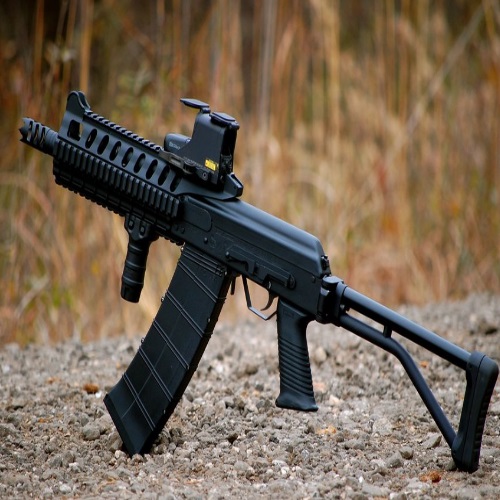Even if you’ve never heard the name Armalite, there is no question that you’ve at least heard of a few of their legendary rifle platforms. As the original developers of the AR-10, AR-15, and M-15, their designs have become some of the most widely developed and persistently used weapons in the last 50+ years. Having seen combat action in nearly every major conflict since Vietnam, their tried and true platforms have been constantly development from numerous weapons developers over the years. Likewise, these models have persisted as a favorite for sportsmen, law enforcement, and military alike.
You may also like our feature on The History of the M16
Company History
Despite the successes of many of their rifle designs, Armalite’s existence as a company has been somewhat tumultuous. Originally, Armalite was just a tiny company based in a small machine shop in Hollywood, California. The California company began as the brainchild of George Sullivan, the patent counsel for the Lockheed Corporation (which would later become the renowned aerospace technology company, Lockheed Martin). Eventually, Armalite would become a subdivision of Fairchild Engine and Airplane Corporation in 1954 by Fairchild’s then-president Richard Boutelle.
With only a handful of employees and limited capital, Armalite was never intended to become a weapons manufacturer. They originally designated the majority of their resources to producing concepts and designs with the intent of licensing them to larger companies. One of Sullivan’s best decisions was hiring Eugene Stoner, a talented weapons inventor. The two engineers fatefully met at the testing of one of Armalite’s first survival rifle prototypes at a local shooting range. Sullivan and Stoner’s first couple designs competed for government contracts but saw little success. Nevertheless, they started to see things come together after they developed their AR-10 and AR-15 rifle designs.

The AR-10 & AR-15 were extremely innovative rifle platforms and were completely new to the weapons market. However, Armalite wasn’t able to produce either rifle in serious quantities and was forced to license both designs to Colt in 1959. This licensing agreement could basically be considered the beginning of the end for the original Armalite corporation. They continued producing new designs, but since none were able to match the AR-10 or AR-15, they stopped new rifle development in the 1970s and effectively ceased company operations.
From 1983 through 1996, the Armalite brand floated from owner to owner until it was eventually sold to Mark Westrom, a former U.S. Army officer, and rifle inventor. Westrom revamped the company and began producing the AR-10 and AR-15 rifles again while also developing several new long guns and pistols. Westrom sold Armalite Inc. to Strategic Armory Corps in 2013, and they have continued in his footsteps by producing top-tier rifles for shooters in nearly every corner of the market.
Armalite AR 10
The AR-10 battle rifle was Armalite’s first design that saw any kind of success in the field. Originally developed by Eugene Stoner in 1956, the AR-10 was significantly easier to fire than other infantry rifles of its era. Similarly, the platform’s innovative straight-line barrel & stock design was made of phenolic composite and forged alloy parts resulting in a rifle over 1 pound lighter. In 1957, the AR-10 competed for a U.S. Army contract against Springfield Armory’s first version of the M14 and their version of the FN FAL rifle. While it was impressive, it was unable to push its way to the top of the pile and the M14 won the contract.
The AR-10 saw limited production success, despite its innovative design. Nonetheless, Dutch arms manufacture Artillerie Inrichtingen purchased a five-year manufacturing license for the AR-10 but less than 10,000 units were ever assembled, mainly for service use by the Portuguese and Sudanese military. Thus, there were three identifiable versions of the AR-10; the “Sudanese” model, the “Transitional” (a.k.a. “Hollywood”) model, and the “Portuguese” model.

Armalite AR 15
Armalite’s AR-15 rifle was their immediate follow up to the AR-10. It was unable to save the original company, despite all of its advantages over its predecessor. However, that does not mean the AR-15 faded out like the company that designed it. Compared to the AR-10, the AR-15 was designed as a smaller & lighter rifle made to fire the 5.56 mm round. This new high-velocity, small-caliber, lightweight cartridge would have allowed U.S. soldiers to compete with Viet Cong fighters carrying AK-47s during the Vietnam War.
Military testing proved that a 5- to 7-man soldier team armed with AR-15s had the same power as an 11-man team armed with the M14s that beat out the AR-15s predecessor for the same military contract. The U.S. was hesitant to put the rifle into combat use and thus it was never very widely used in Vietnam. This reluctance turned around when Armalite sold their design rights to Colt and redesigned the AR-15, aptly named the Colt Armalite AR-15 Model 01,
It wasn’t until 1964 that Armalite’s AR-15 platform saw heavy action on the battlefield. It just took the Army slightly modifying Colt’s AR-15 and rebranding it as the well-known M16. Though the AR-15 was only produced for 5 years between 1959 and 1964, the rifle continued to see service use through the 1990s by the U.S. Secret Service and other law enforcement agencies.

Armalite M15
Nowadays people throw around the terms “AR-15” and “M-15” without much discretion, but what is the actual difference between the two? As you now know, Armalite was forced to sell the name and manufacturing license for the AR-15 to Colt in 1959. They completely lost the rights to their beautiful brainchild, and so did everybody else. Only Colt can produce rifles under the AR-15 name, so the M-15 was the name Armalite adopted so they could still market their rifle to the public. While they have regained the rights to the AR-10, Colt still holds a tight grasp on the AR-15.
In fact, other manufacturers building rifles on the AR-15 platform are forced to do the same thing, which is why you also find rifles like the Bushmaster XM-15 or the Rock River Arms LAR-15. If you’re looking to pick up an AR-15 platform rifle from the original producers Armalite has 15 different variations of the M-15. Although these rifles don’t have great sales numbers, they are pretty impressive nonetheless.

Armalite Eagle 15
Most of Armalite’s AR-10 and M-15 rifles will pack a pretty heavy punch on your wallet. In order for the company to capitalize on the less expensive portion of the market, they developed a division within their company called Eagle Arms. They are solely dedicated to producing a more budget-friendly line of Armalite-style rifles.
For instance, Eagle Arms has six variants of what they call the Eagle-15 that range from only $599 up to $996. As far as the AR-15 platform goes, the Eagle-15 is one of the most affordable rifles you can get that doesn’t sacrifice performance for the lower cost. You should definitely take a look at Eagle Arms if you’re looking to add a rifle to your collection without breaking the bank.
Armalite 50 BMG
Armalite’s AR-50 is their attempt at a .50 caliber long range sniper rifle, and they managed to do a pretty good job with it. It is a well-built rifle with a 30” tapered barrel that measures nearly 60” long when fully-extended. Besides for its noticeable length, the 50 BMG is also quite heavy, weighing in at 34.1 lbs. The single-round bolt-action rifle has a butter smooth action and a single stage trigger. Likewise, thanks to Armalite’s incredible engineering, the AR-50’s recoil feels relatively minimal (even though they gift you a bottle of Tylenol). Despite its comfortable recoil, you certainly wouldn’t want to be standing on the opposite end of this rifle.
Their newest model, the AR-50-A1B, features a smoother action, new bolt stop, and more heavily reinforced muzzle brake. They also produced a version of the rifle that chambers a .416 Barrett round, called the AR-50-A1B-416, for anybody who might want to shoot a slightly smaller caliber round with the same incredible performance.

Armalite AR 30
Armalite’s AR-30 family of target rifles could be considered the little brothers to the big and powerful AR-50 BMG. Originally produced in 2000, AR-30s were built in 2 caliber variants, .338 Lapua and .300 Win Mag. However, they can chamber .338 Lapua, .300 Winchester Magnum, and .308 Winchester, while the AR-30a1 can chamber the .338 and .300 but not .308. Though the AR-30 rifles are still nothing to mess with, they both weigh in at less than half the weight of the AR-50, at 15.4 lbs. and 14.5 lbs., respectively. They are also around 10” shorter than the 50BMGs, measuring 50.1” and 48.1”. The additional 2” on the .338 Lapua can be attributed to its 26” barrel compared to the 24” barrel on the .300 Win Mag. The AR-30 is still quite similar to the AR-50 in that it’s a bolt action with a single-stage trigger. Yet both variants of the AR-30 are magazine fed rifles making them much more efficient to shoot compared to the AR-50.

Conclusion
How do you wrap up an article about a company that designed one of the most influential weapons in modern times? That’s a tough question to answer, but I think I’ll just put it this way: Without Armalite and its development of the AR-15, the world as we know it would be completely different. Armalite’s brilliant engineering led to the M-16 and M-4 rifles, which have undoubtedly changed the world.
Thanks for joining us here at Gunivore!


